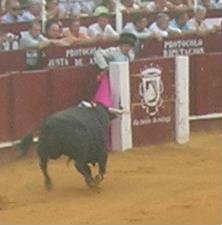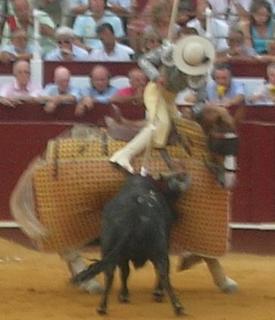Corrida de Toros

This entry graphically describes Una Corrida De Toros. A bullfight is probably everything you thought it would be, but if you care to know for sure read on.
In Malaga yesterday I went to a bullfight. I was not disgusted by it because, generally, the bull is held in great esteem. What is difficult to watch is when the matador doesn't make a clean kill on the first try. Unfortunately this night there were novice bullfighters and so I saw a couple unfortunate ends. In each corrida there there are six fights; six bulls and three matadors. The bull is truly an awesome beast and It´d be a good fight to see a lion and a spanish bull duke it out. Generally the fight is broken into four parts. The first is where the bull parades around the grounds and a few matador-like people come out and taunt him run at their muleta (cape) to show the speed and strength of the beast. Occasionally they had the courage to sidestep the bull's charge at the last second, but more often than not they waved the muleta and then behind the guardwalls as seen below (I don´t blame them):

Next comes the first bloodshed when the picadores come out. Don´t read further unless you´re interested in bullfighting and want to read the details. The picadors are the men on horse back that stab the bull in the neck with a lance type deal. All the wounds to the bull are in the gigantic neck muscle that can be seen in profile in the first picture. The picadors lance stabs about six inches deep into the bull. I became aware at this time that the bull is not the only casualty of the bull fight, often the horses don't make it either. Before the horses had padding, without fail the horse would die a gruesome death in the ring from wounds given by the bull. Despite heavy armor that now covers the side of the horse, on occasion the horse will die from internal bleeding. It seems that two picadors come out, but only one of them is used, whomever the bull selects first.

After the picadors come the three banderilleros. Each banderillero has a pair of barbed, colored banerillos (short spears) that they attempt to lodge in the bulls neck. Each banderillero gets one attempt to stick both their banerillos in; rarely were they successful with two. the photo below is the second banderillero taking a go:
Finally the matador comes out and does his show and after 15 minutes or so kills the bull by sticking his sword in between the shoulder blades right through to the heart. After the fight the bull is dragged out of the ring by a couple extravagantly ornamented horses

 From what I´ve read in Hemingway´s treatise "Death in the Afternoon" and heard from professors at school, the matador is frequently trying to show his confidence and mastery over the bull. Often this includes a lot of strutting around, fighting the bull from his knees, turning your back on the bull, and always trying to make his chest as big as possible. While perhaps seeming acts of arrogance, the bullfighter has enormous respect for the animal.
From what I´ve read in Hemingway´s treatise "Death in the Afternoon" and heard from professors at school, the matador is frequently trying to show his confidence and mastery over the bull. Often this includes a lot of strutting around, fighting the bull from his knees, turning your back on the bull, and always trying to make his chest as big as possible. While perhaps seeming acts of arrogance, the bullfighter has enormous respect for the animal. Bueno, that´s a bullfight and I´ll write more later on the excursion to Ronda and Malaga in general.



0 Comments:
Post a Comment
<< Home